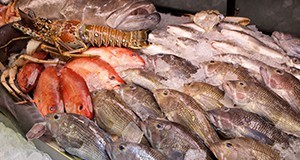Abstract
El marisco es un término general para todo tip de pescados y mariscos (USDA 2010). Los mariscos son parte del “grupo de alimentos de proteína” de MyPlate y también proporciona otros nutrientes necesarios para una buena salud (USDA 2011). Como hay muchos beneficios para la salud associados con la inclusión de los mariscos en la dieta, se recomienda que los adultos consuman al menos ocho onzas de una variedad de mariscos cada semana. Mientras que comer más mariscos se recomienda como parte de una dieta saludable, es importante tener en cuenta su presupuesto al hacer compras de mariscos. Este artículo explica los beneficios para la salud de los mariscos y ofrece algunas estrategias para ahorrar dinero para hacer los mariscos más asequible.
This revised 4-page fact sheet is the Spanish-language version of FSHN14-05/FS247: Shopping for Health: Seafood. Written by Michelle Brown and Wendy J. Dahl, and published by the Food Science and Human Nutrition Department, December 2015.
FSHN14-05s/FS275: De Compras Para la Salud: Mariscos (ufl.edu)
References
Fish Watch. 2017a. "Sustainable Seafood: FAQs" Retrieved October 9, 2013 from https://www.fishwatch.gov/sustainable-seafood/by-the-numbers
Fish Watch. 2017b. "Health: What about Mercury?." Retrieved June 7, 2017 from https://www.fishwatch.gov/eating-seafood/health
Food and Drug Administration (FDA). 2017. "Fresh and Frozen Seafood: Selecting and Serving it Safely." Retrieved June 7, 2017 from http://www.fda.gov/Food/ResourcesForYou/Consumers/ucm077331.htm
National Fisheries Institute. 2017. "Handling and Storage." Retrieved June 7, 2017 from http://www.aboutseafood.com/cooking/handling-storage
NOAA Fisheries. 2017. "Storing your Seafood." Retrieved June 7, 2017 from http://www.seafood.nmfs.noaa.gov/consumertips/07_storingyourseafood.html
Seafood Health Facts. 2017a. "Canned Tuna." Retrieved June 7, 2017 from http://www.seafoodhealthfacts.org/seafood-choices/description-top-commercial-seafood-items/canned-tuna
Seafood Health Facts . 2017b. "Description of Omega-3's and Their Role in Human Health." Retrieved June 7, 2015, 2013 from http://seafoodhealthfacts.org/seafood_nutrition/practitioners/omega3.php
Seafood Health Facts . 2017c. "Guide to Selecting Seafood." Retrieved June 7, 2017 from http://seafoodhealthfacts.org/seafood_safety/patients/handling.php
Seafood Health Facts . 2017d. "Mercury in Seafood." Retrieved June 7, 2017 from http://seafoodhealthfacts.org/seafood_safety/practitioners/mercury.php
Seafood Health Facts . 2017e. "Seafood Nutrition Overview." Retrieved June 7, 2017 from http://seafoodhealthfacts.org/seafood_nutrition/practitioners/seafood_nutrition_overview.php
Stiles, M., A. Kagan, H. Lahr, E. Pullekines, and A. Walsh. 2013. "Seafood Sticker Shock: Why you may be paying too much for your fish. Retrieved June 7, 2017 http://oceana.org/sites/default/files/reports/Oceana_Price_Report.pdf
U.S. Department of Agriculture. 2011. "ChooseMyPlate." Washington, DC. Retrieved June, 2017 from http://www.choosemyplate.gov/index.html
U.S. Department of Health and Human Services and US Department of Agriculture. (USDHHS and USDA). 2015. 2015-2020 Dietary Guidelines for Americans. 8th Edition. Available at http://health.gov/dietaryguidelines/2015/guidelines/
Vermeulen, E., F. Sedor, and S. Kimm. 1983. "Effect of water and rinsing on the sodium content of selected foods." Journal of the American Dietetic Association 82(4):394-396. https://doi.org/10.1016/S0002-8223(21)00098-5

